|
|
Maritime Topics on stamps :
Flying-P-Liner !
|

| |
German barque "Passat" in mighty storm
|
At the time of the Windjammer sailors called sailing ships of the Hamburg shipping company
Ferdinand Laeisz "Flying P-Line" . The ships were famous on their speed,
their safety and reliability in complying with the timetables.
They were painted in the colors black (hull above the waterline), white (water line)
and red (on the hull).
These colors correspond to the national flag of the German Empire from 1871-1918 (see below
the Hamburg port picture).
|
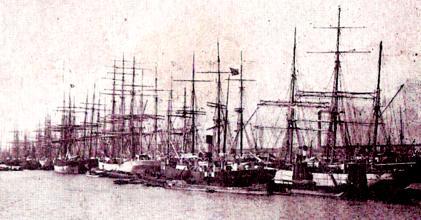
| Hamburg's Sailboat Harbour in the late 19th Century.
These are two postcard images.
|
In 1824, Ferdinand Laeisz founded a production company for hats. As he was expanding his business
into foreign countries, he bought a brigg and named her after his son Carl in 1839 .
Only when his son Carl Laeisz 1853 joined the company, the shipping business was resumed.
In 1857 their first newly constructed vessel was built. The wooden barque was named after the
nickname of Carl's wife, Sophie Laeisz, which was "poodle" . This was because Mrs. Sophie Laeisz
had highly curly hair.
|
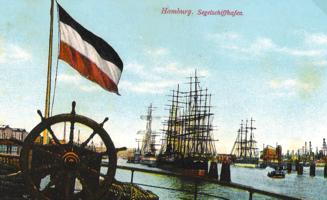
| |
From 1861 on all their new ship buildings got names starting with the letter "P".
That is why the British sailors called the new shipping company at first the "P-Line".
Later this became the "Flying P-Line". All in all 66 out of the 86 sailing vessels of Laeisz had
a name beginning with a "P". Ships with other names were purchased.
|
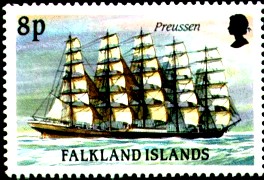
|

|
Soon it became the goal of Laeisz ships to excel in making quick voyages and weather the heavy storms.
While the first ship hulls were still made of wood, they were soon built with iron, and from 1887 on
in steel. Masts and spars were also made of steel.
The rigging was partially replaced by wires and chains. The shrouds were no longer provided with ropes, but replaced
with wooden steps like a staircase to get up safer and faster.
In 1892 the "Placilla" introduced the first "three-island-type". Between the high forecastle and the
lower poop an elevated center construction was placed.
It filled the whole width between both sides of the
hull (as can be seen above on the "Preussen" mark).
The house of cards and the helm had its place here. Therefore this central building was also
called the bridge deck.
To get safely from the bridge deck to the forecastle or poop deck,
the three islands were later connected with walkways.
All Laeisz sail vessels had no auxiliary engine. Upon arrival in Cuxhaven they were towed to the
port of Hamburg.
|
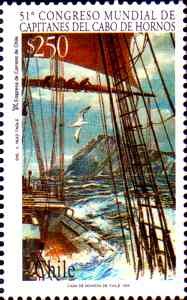
|

|
The stamp on th left hand side shows the rocks of Cape Horn, sailors striking the sails, while a wave crashes down on the deck.
Above, a sailing ship off Cape Horn.
| |
Laeisz Ferdinand's successor, Carl Ferdinand Laeisz and Carl Laeisz were among the last ship-owners, who used the cargo sailing ships and actually were very successful this way.
In particular the ships were run on the potassium nitride route, transporting natural saltpetre from Chile to Europe. In the thirties part of the fleet also carried wheat from Australia.
On their way down from Europe to Chile the ships carried industrial goods, or sailed under ballast.
On both ways the outward and return route involved to round Cape Horn.
|

|
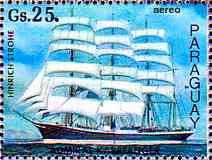
|
All sailors fear Cape Horn, as it is infamous for its frequently raging storms and hurricanes.
Most of the time the winds blow from the west. For sailing ships wanting to get from the Atlantic into the Pacific ocean,
they must tack against storms, with high seas, pouring rain, bitter coldness and poor visibility.
Standing on wildly shaking flooded decks, the crews had to fight with stiff sails and frozen ropes,
with ever more breakers smashing down on them. Only with superhuman strength could they survive
the hardships and round Cape Horn successfully.
Many ships were lost off Cape Horn. As one example among many, we mention the school sailship
"Admiral Karpfanger" (stamp on the right). She was lost in the area around Cape Horn,
only a few pieces of wreckage were found.
See also our special on Cape Horn.
|

|
The robust Flying P-Liner rounded Cape Horn in weather conditions, when other ships turned
back seeking protection in harbours. Able Laeisz captains succeeded in keeping strong crews
with good treatment, food and pay. The payback was in fast voyages.
The area from 50° south in the Atlantic to 50° south in the Pacific is commonly referred to as the
Cape Horn region. To get from one side to the other the sailing ships had to cover 1,200 nautical
miles.
The fastest rounding of Cape Horn ever was achieved by the four-masted barque "Priwall"
(stamp on the left). In just five days and 14 hours she set an all - time record mark for sail ships
in 1938 (!), which will probably never be broken. To put it into relation: in 1905 the full-rigged
ship "Susanna" fought 99 days until the Cape Horn was rounded.!
|
Technical data about the "Priwall":- Built 1917, dockyard Blohm & Voss, Hamburg
- L*B*T 115m * 14.4m * 7.2m
-
BRT / NRT 3185 / 2834 tons after reconstruction in 1926
- sail area 4100 qm
-
Height of the main mast 54m above waterline
- best days run 384 nm, i.e. 16 kn aboaut 24 hours
- 1941 sold to Chilean Navy,
1945 total loss by fire.
|
The famous Captain Robert Hilgendorf marked several record turns with his five-mast-barque "Potosi".
In 1904 the "Potosi" made the voyage from Chile to England in 57 days, and in the opposite direction
it took her only 59 days. Other sailships (and crews) spent 80 to 100 days.
Captain Hilgendorf reached with the ship a top speed of 19 knots, his best days run
were 376 nautical miles. According to another source, in 1900 the "Potosi" made a days run
of 540 nm, which corresponds to an average speed of 22.5 knots over 24 hours. Thus the previous
record of the clipper "Lightning" was broken.
Hilgendorf used the wind and current maps of the North Atlantic and the sailing instructions of
the American hydrographer Maury. All Laeisz captains collected weather, wind and current data
and shared their experience with each other.
|
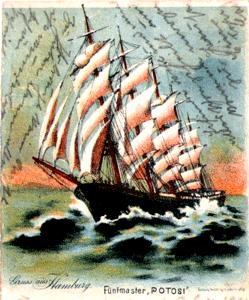
Here is the "Potosi" on an old postcard
| |
Robert Hilgendorf was nicknamed the "flying German" or the "Düwel of Hamborg".
There were several excellent, experienced captains on the Laeisz sailships, who founded
the glory of the line with their high ability, knowledge and responsibility.
In the "Instructions" for skippers Carl Laeisz wrote:
"My ships can and shall make quick trips. It follows that all that this is necessary to this end,
must be on board, such as rigging, sails, ropes, etc. and must be complete and in the very best
condition ....".
Then follow details on repairs, equipment, supplies, sobriety, medical examinations and ...
"....cabin boys will only be hired if I hire them, and I hire only sons of sailors, who were
brought up on the waterkant (seaboard)...".
|
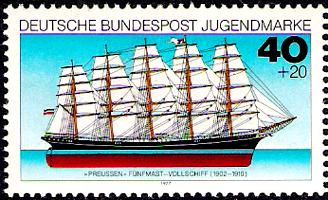
|
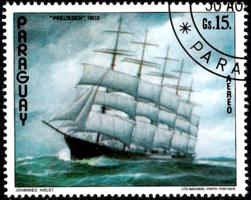
|
The shipping company Laeisz believed in the future of steel sailships and experimented with
five masted riggs, first with the five mast barque "Potosi" in 1895.
In the year 1902 the five mast fullrigger "Preussen" (on all three stamps) , was aimed at becoming
the prototype for the sailing ship of the future, but the big jump in size did not turn out well.
The ship took about 8,000 tonnes of cargo, too much. It was hardly possible to organize
schedules to the outlying ports of South America. The "Preussen" was lost in the Channel off Dover
in 1910, because a mail steamer took the sailboats right of way.
|

| |
Laeisz used the chance to
replace the "Preussen" with the "Peking" and "Passat", both of them just half as big.
These four-masted barques seemed to be ideal for the salpetre run, with respect to size and type,
and became the role models for all future new constructions.
More info on the "Preussen" can be found
in Seemotives site on the "Preussen", click on this line.
|
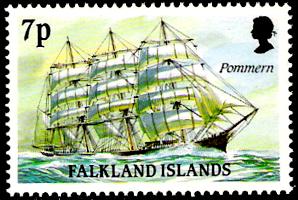
|
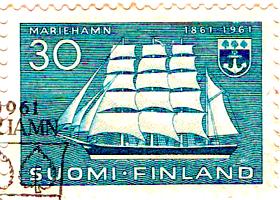
|
During World War I, many P-Liners were interned on their salpetre runs in Chile and had to then
be surrendered as reparations to the Allies.
The detention in Chile, however, proved fortunate: at the end of the war the ships were sailed
back to Europe, the Allies allowed the shipowners to load the ships with cargo on their own account,
before they had to turn in the vessels.
The loads of salpeter achieved such big profits, that F. Laeisz could buy back most of his ships
again.
|

|
The four-masted barque "Pommern" shown here was built in 1903 under the name "Mneme" in Glasgow.
From 1906 to 1921 she sailed under Laeisz flag.
She has a sail area of 3240 square meters, a crew of 26 men and ran with a good wind 16 knots.
|

|
Because of the similarity in design and size the final eight four-masted barques of F. Laeisz
were called "The eight sisters": "Pangani" (1903), "Pechili" (1903), "Pamir" (1905), "Peking" (1911),
"Passat" (1911), "Pola" (1918), "Priwall" (1920) and "Padua" (1926).
|
The "Padua" was the last tall ship that was built solely for cargo voyages.
Some data of the "Padua":
- Built 1926, dockyard Tecklenborg, Geestemünde
- L*B*T 114.5m * 14m * 7.3m
-
BRT / NRT 3064 / 2678 tons
- sail area 3800 qm
- sailing for Laeisz company from 1926 to 1946
- her best voyage in 1927 from lightvessel "Elbe 1" to Talcahuano, Chile, in 54 days!
|

|

|
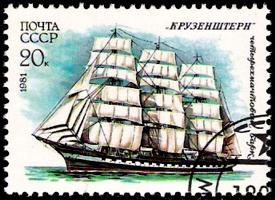
|
After World War II, in 1946 the "Padua" was surrendered to the USSR and was renamed "Krusenstjern".
The sailship is now a school ship and is the only one of the Laeisz sailing ships,
which is still underway.
In 2005-2006 the ship did not only round Cape Horn, but also the whole world,
see the stamp on the left.
Today she has a skeleton crew of 76 men and can take up to 160 cadets.
|
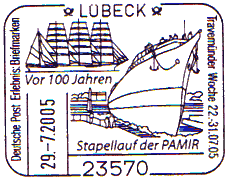
|

|

|

|
Only four Laeisz Windjammer have still water under her keel:
- "Pommern" ex Mneme, four-masted barque, museum ship in Mariehamn (Finland)
- "Peking", four-masted barque, museum ship in New York
- "Passat", four-masted barque, museum ship in Travemünde, see cancellations
- "Padua", four-masted barque, now as Russian sail training ship "Krusenstjern" in action
Today (2010), abou 50 ships comprise the fleet of the shipping company "F. Laeisz".
The fleet inventory includes reefers, bulk carriers, gas carriers, ro-ro carriers,
car transporters, research vessels and container ships.
|

|

|
Some data about the "Passat":
- Built 1911, dockyard Blohm & Voss, Hamburg
- L*B*T 115m * 14.4m * 7.3m
-
BRT / NRT 3181 / 2870 tons after reconstruction 1927
- 34 sails with an area of 4100 qm
-
highest sailing speed 17,4 kn
- crew 25 - 35 men, as training vessel skeleton crew of 35 men and up to 51 cadets.
- She sailed under the Laeisz flag from 1911 to 1921, as war indemnity short time
under the French flag and then repurchased and was sailing for Laeisz from 1922 to 1932.
|

|
On this personalized stamp You see a paintig of the Flying-P-Liner "Peking" by
Emilio Biggeri.
|
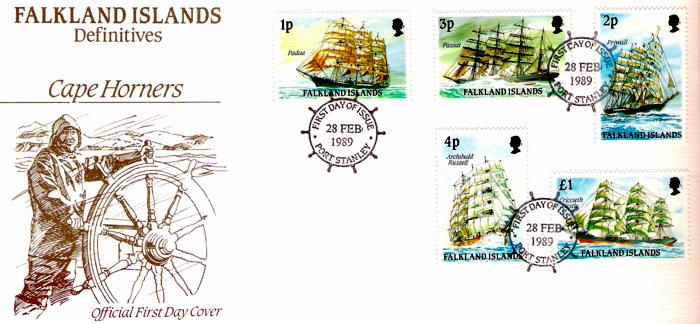
| |
Following pages matches sailing themes on seemotives internet pages: click only on the corresponding line.
|
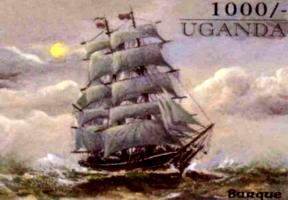
|
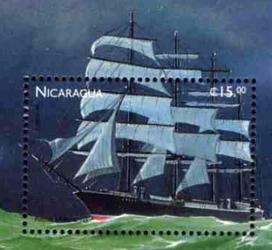
| |
Sources :
Peter Klingbeil, die Flying P-Liner, Verlag die Hanse, 2000
about "Potosi":
Peter Freuchen, Knaurs Buch der sieben Meere, Droemersche Verlagsanstalt, 1958
Wikipedia Internet Enzyklopädie
|
© Bjoern Moritz, all rights reserved.
|